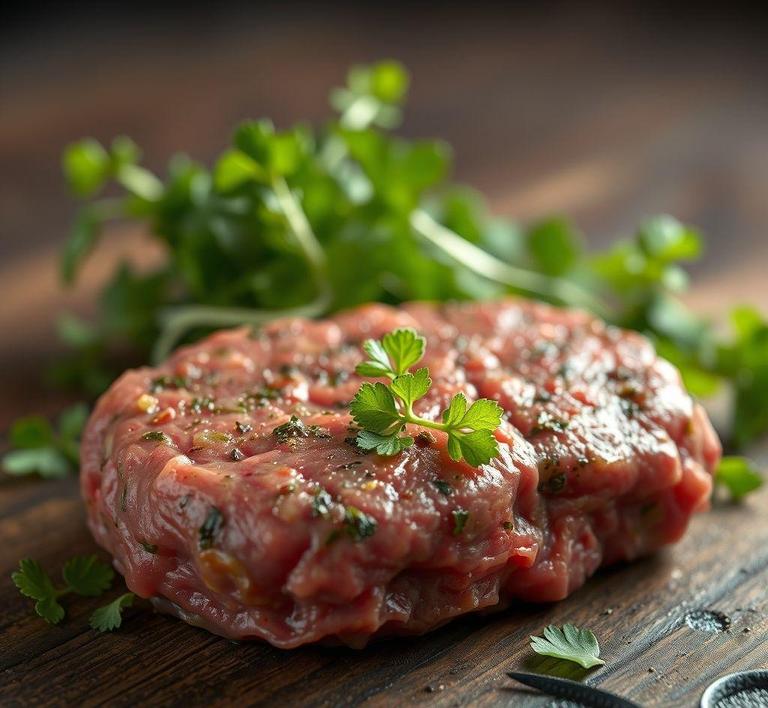When it comes to food safety, knowing how to properly store and handle ground beef is key, especially when it comes to refreezing it. While many of us are familiar with the usual rules around freezing meat, the process of refreezing ground beef can be a bit tricky if you don’t follow the right steps. If you’ve thawed ground beef and don’t plan on using it, don’t panic-you don’t necessarily have to toss it out! In this guide, we’ll walk you through the dos and don’ts of refreezing ground beef, so you can keep your meals safe and tasty without any waste.
Can You Refreeze Ground Beef?

Ground beef is one of the most versatile and widely used meats in kitchens around the world. It’s a staple for everything from burgers to meatballs to taco fillings. But what happens if you’ve bought too much, or perhaps thawed more than you need for a recipe? Can you refreeze ground beef after it has been thawed? This is a question that many home cooks ask, especially when they want to avoid waste while preserving the quality of their food.
The simple answer is: yes, you can refreeze ground beef, but there are important factors to consider to ensure safety and maintain quality. Thawing and refreezing meat can be a bit tricky, as improper handling can affect both the taste and texture of the beef. The key to safely refreezing ground beef lies in how it is thawed and stored. If done correctly, it can be perfectly fine to refreeze beef after it has been thawed, but you must follow specific guidelines to ensure it remains safe to eat.
How To Refreeze Ground Beef?
Refreezing ground beef should be done with caution. Here’s a step-by-step guide on how to do it right:
1. Thawing The Beef Safely
The first step in the process is to ensure that the ground beef was thawed properly. If you thawed the beef in the refrigerator, you’re in the clear. Thawing ground beef in the fridge keeps it at a safe temperature (below 40°F or 4°C), preventing bacterial growth. Thawing on the counter or at room temperature, however, is not recommended as it can cause the beef to enter the "danger zone" (40°F to 140°F or 4°C to 60°C), where bacteria multiply rapidly.
2. Refreezing Immediately
If you’ve thawed ground beef in the fridge and haven’t left it sitting out for long periods, you can safely refreeze it. The beef should be returned to the freezer within 1 to 2 days of being thawed. Make sure it’s in an airtight container or wrapped tightly in plastic wrap or aluminum foil to prevent freezer burn.
3. Portioning The Beef
If you know you won’t need all of the ground beef at once, it’s a good idea to portion it into smaller amounts before freezing. This way, when you refreeze it, you can pull out just the right amount for a future recipe. Also, it reduces the need for repeated thawing and refreezing, which can further affect the beef’s quality.
4. Labeling And Storing
It’s important to label each package with the date of refreezing. This helps you keep track of how long the beef has been frozen. Ground beef can be kept in the freezer for up to 3-4 months for the best taste and texture, but it remains safe to eat indefinitely if kept at 0°F (-18°C). Over time, the texture and flavor may deteriorate, so try to use it within a few months for optimal results.
5. Checking For Quality
When you refreeze ground beef, check the texture and color once it’s thawed again. If the beef has become discolored or has an off smell, it may not be safe to eat. Refreezing can sometimes cause the beef to lose moisture, which can result in a slightly less juicy and more crumbly texture when cooked. However, as long as it was handled safely, it will still be fine to eat.
Quality Impact
Refreezing ground beef isn’t just about safety-it’s also about quality. While it is safe to refreeze ground beef as long as it has been thawed and handled correctly, the process can affect its texture, flavor, and overall eating experience. Here’s how:
1. Texture Changes
One of the biggest impacts of refreezing ground beef is its texture. The freezing process causes the water in the meat to form ice crystals. When these crystals are large, they can puncture the meat’s cellular structure, causing the beef to lose moisture during thawing. This can make the beef drier and more crumbly than it would be if it hadn’t been refrozen.
2. Loss Of Juiciness
Ground beef is naturally high in fat, which helps keep it juicy when cooked. However, when refrozen, some of this fat can be lost, making the meat less juicy when you cook it a second time. This is especially true if the beef is thawed in the microwave or at room temperature, which can cause fat to melt off prematurely. To mitigate this, try to refreeze beef while it is still as fresh as possible and avoid letting it sit at room temperature.
3. Flavor Deterioration
While refreezing doesn’t directly impact the flavor of the beef, the process of thawing and refreezing can lead to the loss of some of its flavor. The longer ground beef is stored and exposed to air (even if wrapped tightly), the more susceptible it becomes to freezer burn, a condition where the meat dries out and loses its rich, meaty flavor. To avoid this, make sure the beef is tightly wrapped or sealed in a vacuum-sealed bag before freezing.
4. Potential For Dryness
Since refreezing causes some loss of moisture, you might notice that the meat becomes drier when cooked. If you’re using the beef in a recipe like chili or a casserole, this might not be as noticeable, but in dishes where the beef is the star, like burgers or meatballs, the change in texture can be more apparent.
While it is safe to refreeze ground beef after it has been thawed, the process does have some impact on the quality. If you follow the proper thawing and refreezing guidelines, there’s no reason why you can’t extend the shelf life of your ground beef for future meals. However, it’s important to be aware of the potential changes in texture and flavor that may occur. If you can, try to use ground beef that has only been thawed once, as this will provide the best texture and taste.
So, whether you’ve thawed too much beef for a single meal or are simply looking to preserve some extra meat, refreezing is a viable option. Just be sure to handle the beef carefully and keep in mind that while it remains safe to eat, the experience might be a little different than when it was fresh. By following the right steps, you can ensure that your ground beef is still tasty and safe to eat, even after it’s been through the freezer twice.
Is It Safe To Refreeze Ground Beef?
When it comes to food safety, few topics are as nuanced as freezing and refreezing meat. Ground beef, in particular, is one of those items that many people wonder about when it comes to refreezing after it’s been thawed. The short answer is yes, it is generally safe to refreeze ground beef, but there are several important factors to consider to ensure you’re not compromising its safety or quality.
Understanding the Process of Refreezing:
Freezing meat works by slowing down the growth of bacteria, which is why freezing is a common method of food preservation. When you thaw ground beef, however, it enters a temperature range where bacteria can grow rapidly-this is between 40°F and 140°F (4°C and 60°C), which is considered the "danger zone." The key factor to remember is that ground beef should not sit in this danger zone for more than 2 hours (1 hour if it’s above 90°F or 32°C).
Once you’ve thawed ground beef, you technically can refreeze it, but there are a few caveats. For safety, the meat should be cooked first. Cooking it ensures that any bacteria that may have started to develop during the thawing process are killed off, which makes refreezing safer. Refreezing raw ground beef without cooking can lead to an increase in harmful bacteria, and that can pose a health risk when it’s thawed again.
The Quality Factor:
While refreezing is possible, there is a notable drop in quality with each freeze-thaw cycle. This happens because the water content in the meat forms ice crystals, which break down the meat’s structure. As a result, when refrozen, ground beef can become dry, tough, and less flavorful due to moisture loss. So, even if it’s technically safe, the texture and taste may not be as appealing when it’s eventually cooked.
Signs That Ground Beef Should Not Be Refrozen
Before you even consider refreezing your ground beef, you need to ensure that it hasn’t gone bad. There are a few important signs to look out for that indicate your ground beef is no longer safe to eat or refreeze:
- Off Smell: Fresh ground beef has a clean, metallic scent. If it smells sour, rancid, or like ammonia, it’s a sign that the meat has gone bad, and should not be consumed or refrozen. A foul odor is an indication of bacterial growth, and bacteria thrive when meat is left in the “danger zone” for too long.
- Discoloration: Fresh ground beef is usually bright red, although some darkening may occur around the edges (which is normal due to oxidation). If your ground beef has turned a dull grayish-brown or greenish color, it’s best not to refreeze it. The discoloration can be a sign of bacterial contamination or spoilage.
- Slimy Texture: If the surface of the ground beef feels slimy or sticky, that’s a big red flag. This could be a result of bacteria multiplying in the meat. In this case, even cooking it will not make it safe for consumption, and it should be thrown away.
- Improper Thawing: If the ground beef was thawed improperly (e.g., left out at room temperature for extended periods), it may already be unsafe to eat, let alone refreeze. Ground beef should be thawed in the fridge, microwave, or under cold running water-never on the countertop, where bacterial growth can occur rapidly.
Common Refreezing Mistakes
Many people make a few common mistakes when it comes to refreezing ground beef, which can impact both food safety and the final quality of the meat. Here are some things to watch out for:
- Refreezing Without Cooking: One of the most common mistakes is attempting to refreeze raw ground beef without cooking it first. As mentioned earlier, thawed meat should be cooked before refreezing to eliminate the risk of bacterial contamination. Refreezing raw beef without cooking it can multiply any bacteria that might have formed during the thawing process.
- Refreezing After Long Storage: If ground beef has been stored in the refrigerator for more than a day or two, it may already be on the edge of spoiling. Refreezing it at this point can lock in that spoilage and lead to bacterial contamination. Always ensure that the beef has been stored at a safe temperature (below 40°F or 4°C) before deciding to freeze or refreeze it.
- Using the Same Packaging: If you are refreezing ground beef, it’s important to store it in airtight packaging to prevent freezer burn. This can be done by wrapping the beef tightly in plastic wrap, followed by aluminum foil, or using a vacuum-sealed bag. If the original packaging is damaged or opened, simply placing it back in the freezer without rewrapping can lead to freezer burn, which dries out the meat and affects flavor and texture.
- Not Labeling Meat: When refreezing ground beef, it’s essential to label it with the date it was initially frozen and any other important details, such as whether it was cooked before refreezing. This helps you track how long it has been in the freezer, ensuring it doesn’t stay frozen for too long and risk becoming unsafe or losing quality.
Tips And Tricks For Refreezing Ground Beef
To help you make the most of refreezing ground beef, here are a few tips and tricks to follow:
- Portioning Before Freezing: To avoid the need to refreeze large quantities, portion out your ground beef before freezing. This way, you only need to thaw and refreeze what you need, minimizing waste and maintaining the quality of the rest of your meat.
- Use Vacuum Sealing: A vacuum sealer is a fantastic tool for preserving ground beef in the freezer. By removing excess air, vacuum sealing prevents freezer burn, keeping the meat fresher for longer periods. If you’re serious about long-term storage, a vacuum-sealing system is worth investing in.
- Use Ice Cube Trays for Small Portions: If you frequently use small portions of ground beef, try freezing it in ice cube trays or muffin tins. Once frozen, transfer the cubes into a freezer bag for easy use later. This way, you only thaw what you need, and the rest stays fresh.
- Avoid Thawing and Refreezing Multiple Times: Each time ground beef is thawed and refrozen, its quality degrades. To preserve the best taste and texture, try to thaw the amount you plan to use and avoid repeated freeze-thaw cycles. Thaw only what you need, and store the rest for later use.
- Freeze Cooked Ground Beef: If you’re unsure when you’ll use the ground beef, consider cooking it first, then freezing the cooked meat. It’s often safer, and the cooked beef can be reheated more easily without the risk of bacterial growth. It also keeps its texture better than refrozen raw beef.
Conclusion
Refreezing ground beef is a practice that can be done safely, but only under certain conditions. It’s essential to remember that the process of freezing and thawing affects the meat’s texture and quality, often leaving it dry and less flavorful. However, when done correctly-especially by cooking the beef before refreezing-it can be a safe and practical way to preserve food for longer periods. The key to successful refreezing lies in proper thawing techniques, understanding the signs of spoilage, and following best practices for packaging and labeling. By adhering to these principles, you can make the most of your ground beef and reduce waste, all while keeping food safety at the forefront.


